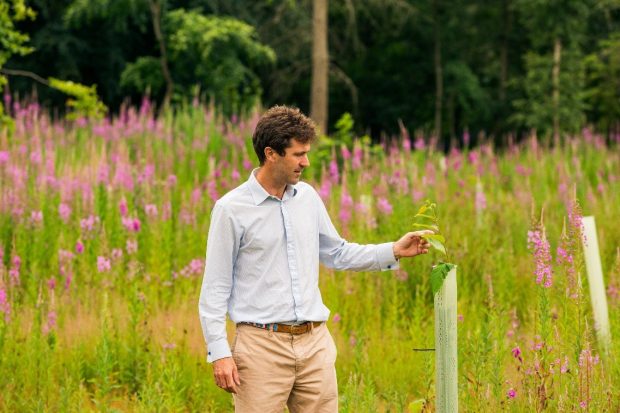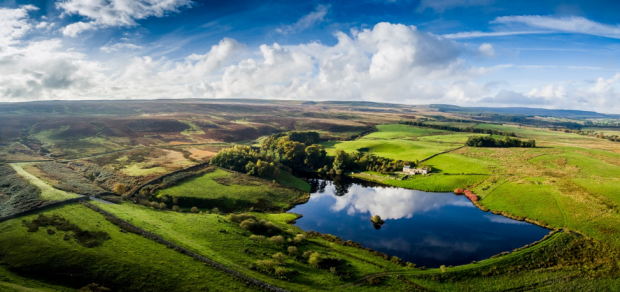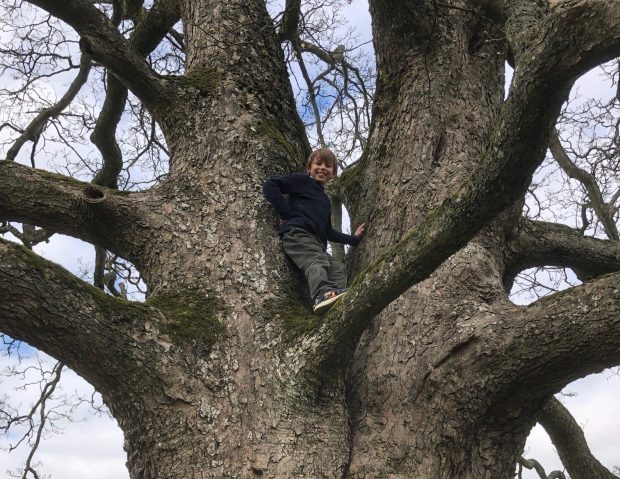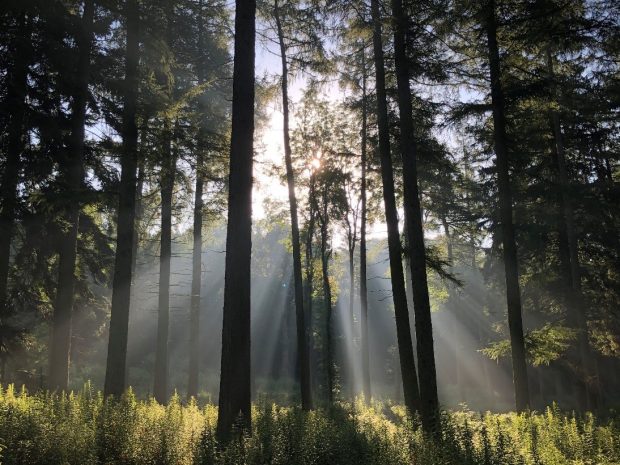There are many benefits to creating woodland for the environment, wildlife, communities and the economy. Sir Edward has been involved in woodland creation schemes for many years, including on Barningham Estate, a 7,000-acre land that his family own and manage on the northern edge of the Yorkshire Dales.
Sir Edward shares his experience of creating woodland and why taking part in the England Tree Strategy consultation, is so important and why you should respond to it to influence the future of England's trees and woodlands.

A family’s love for nature
Barningham Estate consists of around 7,000 acres, just north of the Yorkshire Dales National Park.
As a result of my parents’ love for nature, and the habitat work they carried out, it’s a thriving mixed rural estate, and is home to around 130 species of birds including rarities such as ring ousel, black grouse, curlew and 5 species of owl.
The higher ground is upland heath and blanket bog, leading down through rough pasture, with improved grassland and 500-acres of woodland.
Special areas on the estate include a Site of Special Scientific Interest (SSSI) woodland, and some good examples of Neolithic cup and ring stones and ancient enclosures, which is fantastic for lovers of rock art.
Since my wife and I have taken over the management of the Estate we have continued to improve the land and environment, having planted 100-acres of mixed woodland. We plan on planting much more.

The benefits of woodland creation and tree planning
As well as managing Barningham Estate, I’m also involved in larger woodland schemes with my business partner Andy Howard. So, I’ve seen firsthand how creating and managing larger woodlands also has many environmental benefits.
Over the past 3 years we have managed some of the largest afforestation schemes in the UK, including the 1,000-acre Doddington North Forest, and 2 similar sized projects in the Scottish borders.
I’m particularly proud of the Doddington project: it was a hill farm that had become inundated with invasive bracken and rhododendron. It’s now been 3 years since we planted the site with a mix of broadleaf and conifer trees, which has completely transformed the area for the better, particularly for wildlife.
Insect life has boomed, and several bird species have flourished: skylark, grasshopper warbler, stonechat, reed bunting, kestrels and owls have responded to an increase in vole numbers.

One of my favourite woodlands at Barningham is the Blackcock Wood: 15-acres of sparsely planted larch and scots pine, with birch, holly, juniper, gorse and hawthorn.
The woodland was planted 15 years ago when there were no more than 5 pairs of black grouse. As a result of this habitat improvement, together with excellent game keeping, we now have 30 pairs of these fantastic and very rare birds.
The woodland was used in 2018 to film the grouse for the Wild Britain series. We plan to increase the size of this wood over the next few years, and plant complementary woodlands on the moorland fringe to encourage new leks to establish.
The most spectacular woodlands on Barningham are along the banks of the river Greta and Gillbeck with mature trees and steep banks.
It's one of the only remaining naturally regenerating woodlands in County Durham. As such, it is home to the wonderful pied flycatcher, which is sadly now on the International Red List of Threatened Species.
Working with local landowners to expand and protect woodlands
During the woodland creation process, we work with local landowners who are passionate about creating woodland and leaving a legacy of habitat and biodiversity improvements.
Expanding and protecting woodlands is crucial. To understand nature, we must be involved with it: I would like to see a huge increase in urban and peri-urban planting where larger communities can benefit.
By planting trees and joining existing woodlands together we will not only improve habitats for wildlife, it will also help connect people with nature.

My advice to any landowner who wants to explore woodland creation
My advice would be first to consider the site and the effects a new woodland would have on its surrounding area. It’s often better to expand an existing woodland rather than creating a standalone.
Once a good site for planting has been found, my next consideration would be size: the larger the woodland the better the habitat created and the better the economies of scale. And finally, a landowner should always consider access.
The worst woodlands are inaccessible. Woodlands that are accessible will be well looked after and will provide fabulous habitats and quality timber.
The England Tree Strategy
The England Tree Strategy consultation is open and I think landowners should engage with it because it’s an opportunity to make decisions about land use, woodland and forestry management that could affect us for decades to come.
The government has made pledges to plant thousands of hectares of trees annually to help mitigate climate change and set the UK on its path to net zero. The future Strategy must be influenced by those of us who will be most affected, who live and work on the land.
It’s not too late to submit your views on the England Tree Strategy consultation, which closes on 11 September 2020.
You can take part in the England Tree Strategy consultation here: https://consult.defra.gov.uk/forestry/england-tree-strategy/



5 comments
Comment by Christopher Land posted on
Let us see how many blackgame he has when the trees are grown. It's ridiculous to say blackgame are thriving because of tree planting - if that were the case they would be tripping over them in the Scottish Borders instead of watching them disappear.
Comment by Tom Fletcher posted on
Thetford Forest is a beautiful example of the Forestry Commissions on-going work. High Lodge is a key area of that work and enhances Breckland, Suffolk and Norfolk in general.
https://www.visitbreckland.org.uk/places/united-kingdom/suffolk/brandon/attractions/high-lodge-thetford-forest-centre/
Comment by Martin posted on
I’d like to know more about this family came to ‘own’ these large tracks of land.
Comment by Roger Cartwright posted on
The following letter to the Forestry Commission is based on an article I have written for the RFS Journal after I had already responded to the Forestry Strategy consultation:
The Chief Executive, Forestry Commission
Dear Sir/Madam
Newton Rigg College – a future for land based Practical Education including forestry?
At one time every county in England had an Agricultural College but only Newton Rigg College Cumbria included the National School of Forestry.
It is planned to close Newton Rigg College in July 2021 and a number of leading figures in the county are fighting to save it. The chair of the land based skills steering group is Christine Knipe, Chief Executive of the Westmorland County Agricultural Society and she has assured me that forestry, horticulture and arboriculture are being included in the debate and everyone is invited to give information.
The NFU is organising a survey on this, https://cumbria.onlinesurveys.ac.uk/land-based-skills-strategy-group-farmer-survey .
When the Forestry Commission schools closed in 1969, Newton Rigg took over and built on this training role and began to adjust the courses to reflect big changes in the countryside and national forestry policy.
Martin Clark has provided a personal account of this successful story and how things began to go wrong.
After doing the two years practical experience as a woodman and being accepted on the ‘National Diploma in Forestry' course at Newton Rigg (that in the mid 1970's was quite an achievement)”
He did a B.Sc. in Land Use & Biology in Leicester and (after getting good grades) a M.Sc. in Forestry & its Relation to Land Management at Trinity College Oxford & the Commonwealth Forestry Institute.
After experience in private forestry he joined Newton Rigg in 1987as a lecturer and eventually, with Chris Starr, became Joint Head of the School. During this period, Newton Rigg not only led vocational forestry education in the UK, but also in Europe and the Commonwealth, where the curriculum was used as a model in Canada, Australia, New Zealand, South Africa, India and Sri Lanka
Martin Clark left Newton Rigg 23 years ago and Newton Rigg was taken over by the new University of Cumbria and then by Askham Bryan College.
There is still University education in forestry – in fact the National School of Forestry title has been transferred to the University of Cumbria.
(www.cumbria.ac.uk/study/academic-departments/science-natural-resources-and-outdoor-studies/the-national-school-of-forestry/)
There are many other stories like Martin’s, one ex agricultural engineering student has said: “I was born in Ambleside but I was made at NEWTON RIGG - As you get older you realise that certain people and places had a profound effect on your life”!
This resonates with me, as I trained with the Forestry Commission at the Forestry Commission’s Faskally Forester Training School in Scotland in the 1950’s, where Esmond Harris was one of my instructors and left me with a lifelong belief in the importance of science to successful forest management. I found that my early practical experience and training in forestry provided an ideal introduction to life and helped me throughout my second career as a landscape architect.
The closure of Newton Rigg is relevant to both the “Trees and Woodland Strategy” and the ELM (Environmental Land Management) consultation. It is contrary to the need for many more, well trained and experienced farmers, land management advisers and foresters who have a good understanding of the environment and have been trained to work with each other and more closely with nature. It is an example of the short sighted, lack of joined up thinking by government. If they are serious about successfully delivering the commitments in the Agriculture Act, part of the answer lies in education and it should be a national priority to retain, restore and reinvigorate Newton Rigg College.
I urge the Forestry Commission to take an interest in the future of Newton Rigg College and to strongly support moves to retain it for providing a introductory practical integrated land use and management training, including forestry and arboriculture.
Yours sincerely
Roger N. Cartwright
Diploma LA MLI, Chartered Landscape Architect
Comment by Beth Rees posted on
All over the U.K. there are small and large parcels of neglected ancient woodland - instead of planting more - why not manage the existing woodland; prevent it from dying. Woodland needs managing. You can’t just plant trees and forget about them. It is really upsetting to see these old woods dying.